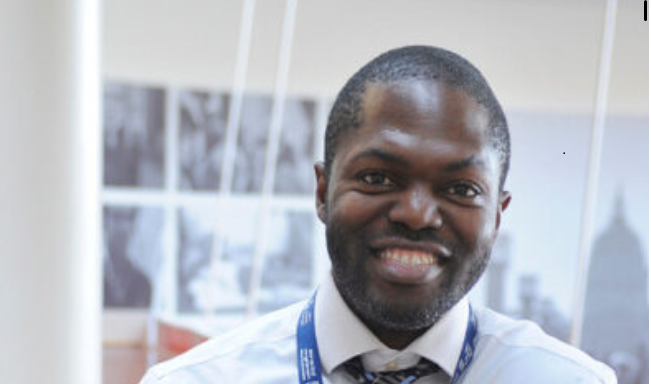 Help the helpers. That well-known adage about securing your own oxygen mask on a plane before assisting others holds true for safety net health clinics. It’s especially apt for those that want to support families who have experienced trauma and toxic stress by screening them for adverse childhood experiences (ACEs), as the clinicians at LifeLong Medical Care have learned.
Help the helpers. That well-known adage about securing your own oxygen mask on a plane before assisting others holds true for safety net health clinics. It’s especially apt for those that want to support families who have experienced trauma and toxic stress by screening them for adverse childhood experiences (ACEs), as the clinicians at LifeLong Medical Care have learned.
Like other members of the 15-clinic cohort in CCI’s Resilient Beginnings Network (RBN), LifeLong had long wanted to grapple with ACEs among its pediatric patients. Left unaddressed, ACEs are linked to health problems that can span a lifetime, including chronic disease, behavioral health challenges, and substance use disorders.
But long before LifeLong’s RBN team even began screening for ACEs such as child abuse, neglect, parental incarceration and other trauma that can take a tremendous toll on a child’s health, the team realized they first needed to support their staff, says Gillian Fynn, formerly a longtime lead clinical social worker at LifeLong Medical Center and a member of the organization’s RBN team as well as an early champion of this cause.
This realization first became apparent in 2018, when a team at LifeLong seized the opportunity to integrate strategies based on ACEs research to prevent and heal trauma in their pediatric patient work after the health center joined CCI’s Resilient Beginnings Collaborative (RBC), a precursor to RBN. In that collaborative, the organization Trauma Transformed, a program of the East Bay Agency for Children in Oakland, trained more than 100 employees who serve pediatric patients at LifeLong’s clinics.
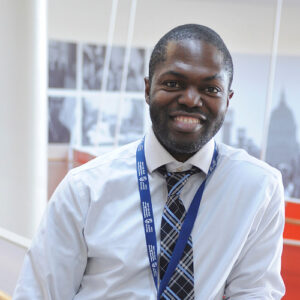
LifeLong physician and associate medical director for pediatrics Omoniyi Omotoso
The initial goal was to pilot ACEs screening in newborns to five-year-olds, according to LifeLong’s, associate medical director for pediatrics Omoniyi Omotoso, in a news account at the time. But staff feedback around an ACEs questionnaire prompted the team to hit the pause button on the roll-out. To begin with, a lot of the staff were uncomfortable because they, too, had experienced childhood trauma and were triggered by the questions on the screening tool.
“Early on, we realized we also needed to spend more time on staff,” said Omotoso, a physician and RBN team member, whose clinical time is spent at LifeLong’s William Jenkins Health Center in Richmond. “We’re trying to be resilient ourselves. We’re reminding our staff about self-care and resources available to take care of themselves and loved ones.”
A visit in 2019 to New York City, to the Bronx-based Montefiore Medical Center—an ACEs screening and trauma-informed care pioneer—helped Omotoso realize the enormous value in a trauma-informed approach for children, caregivers, and staff. He says that it was “mind- blowing” to see how the chief security officer at Montefiore applied these principles in his work and how his team approached patient care. For example, the medical center’s security officers made sure to greet patients on the way in and check to see that they got what they needed on the way out. “There is no such thing as patient-facing staff,” Omotoso says now. “We all provide patient care. Our entire medical home needs to transform culturally to support this work.” The visit, he says, made clear that before starting ACEs screening, his organization needed to be attuned to staff readiness and meet everyone where they’re at. “We began rethinking our strategic approach to incorporate a lot more non-clinicians into our working groups,” he says, and sought their input in the planning and rollout of trauma informed care.
Putting on the oxygen mask
To fine-tune its approach, the team pivoted to provide a deeper level of training and support for its health center’s staff. They discussed ACEs science research, watched a TEDTalk on the topic by trailblazing pediatrician and former California Surgeon General Nadine Burke Harris, and screened the award-winning documentary “Resilience,” about the biology of stress and the science of hope. Each activity was followed by discussions of what was covered in the sessions, such as intergenerational trauma.
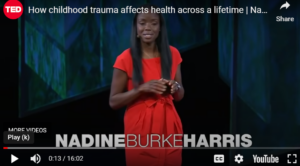
TED Talk on childhood trauma by former CA Surgeon General Nadine Burke Harris
The thinking behind such approaches: Team wellness is key to doing trauma-informed and resilience-based work, according to RBN team member Magdalen Edmunds, deputy chief medical officer for clinical affairs at LifeLong and a family physician. But focusing on team members’ well-being was just the beginning of organizational changes to prepare staff for ACEs screening: LifeLong also switched to a new electronic health record system, Epic, to record ACEs screening results.
Fast forward five years: The health organization continues to embrace staff wellness. It has introduced a mindfulness moment (15 minutes via Zoom) for all staff every Wednesday. Sometimes a Feldenkrais practitioner is in the mix, since the somatic body practice is known to help people relax. Leora Myers, a registered nurse and LifeLong’s holistic health manager, sometimes guides the small group through the gentle movement practice known as qigong.
As in other community health centers, there’s continual staff turnover at LifeLong, so Edmunds is always looking for ways to strengthen workforce retention and employee resilience. “Our staff are really tired and they need resources to sustain them,” says Edmunds, who also has human resources periodically remind employees of all the confidential employment assistance program services they can access, including therapy, coaching, parenting assistance, and financial and legal advice. This is an underutilized internal resource, she says.
On the patients’ side: LifeLong is using the ACEs screening tool known as PEARLS—which stands for Pediatrics Adverse Childhood Experiences and Related Life Events Screener – to screen its families. Beginning on January 1, 2020, Medi-Cal providers became eligible for reimbursement for conducting ACEs screenings for child and adult patients with full scope Medi-Cal. In October of 2021, California enacted the ACEs Equity Act, which expanded ACEs screening by mandating the tool be covered by commercial insurance.
At LifeLong, parents are given the option of identifying which ACEs apply to their child or simply reporting the number of ACEs their child has experienced. Equally important, as Edmunds notes, the process is completely private and confidential: Providers don’t initially see what a patient screens positive for, just that they have a positive ACEs score and what that number is. That privacy helps to start a conversation and build trust, adds Edmunds, in what’s known as a de-identified screener.
LifeLong’s William Jenkins Health Center is also part of an ongoing University of California, San Francisco pilot research project dubbed CARE, which looks at ways to strengthen resilience of patients and their caregivers who screen positive for ACEs. CARE, which stands for Collaborative Approach to building Resilience in Everyone, also includes the Resiliency Clinic at UCFS’s Benioff Children’s Hospital in Oakland and Santa Barbara Neighborhood Clinics. The three-year study is set up with the goal of learning how to help caregivers and children strengthen their relationships and develop skills to better manage stress.
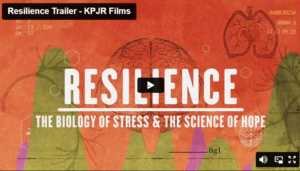
Lifelong providers and staff watched the documentary “Resilience” in preparation for ACEs screening
Another aim of the research is to see how the programs influence the health of children who have experienced high stress events in their lives. Studies have found that if caregivers can provide support, resources, and a safe environment for their children, the harmful physical effects of ACEs are much smaller. In other words, even children who face tremendous adversity can thrive with the right interventions. A third goal is creating a staff resiliency tool kit on how to build and sustain resiliency and develop coping skills to address stress in the safety net clinic workplace.
As part of the study, LifeLong’s pediatric clinic conducts ACEs screening for children ages 2 to 4 and offers what’s known as its ABC program, a 10-session initiative designed to support caregivers and children. In 45 to 60-minute weekly one-on-one sessions—either in-person or online–coaches help parents and caregivers reduce stress and understand their children’s behaviors in an interactive session with their child. To date, around 250 patients have participated in the program. “Families express how glad they are that we are acknowledging their trauma and its impact on them as caregivers and their children,” says Omotoso.
Looking at ACEs through a cross-cultural lens
Like many community health centers, LifeLong has been working hard to diversify its staff. Of its approximately 1,000 employees, 58 percent are people of color, according to Edmunds, yet many “minority” staff can still feel very much, well, in the minority. So more than a year ago, LifeLong hired an external BIPOC consulting firm to facilitate a group for practitioners of color. Shawan Worsley of Culture Ally meets with behavioral health staff and clinicians to talk about racism in health care and the workforce as well as micro- and macroaggressions. She also offers individual coaching and mentoring for BIPOC staffers and works with managers and supervisors around cultural competency and communication.

Angie Santiago, LMC associate clinical social worker
“We’ve never had a BIPOC clinician support group before; I’m very grateful to have one now, as someone who identifies as a person of color and who’s bilingual,” says Angie Santiago, a former LifeLong behavioral health team member. “We’ve been having conversations around supporting each other as clinicians.” Many BIPOC staff feel alone working in the clinic, she says, “so one of our goals is to eradicate that feeling and create a sense of community among clinicians of color. We can’t (just) keep it here — we need our voices heard in terms of our perspective.”
Language and cultural relevance matters, too. After Santiago brought issues of cultural competency to managers’ attention, the organization also formed a support group for Spanish-speaking clinicians. As the mental health provider pointed out, all her supervision was being provided by white staff in a clinic that served a significant Latino population.
Santiago felt that conventional ways of attempting to reach Spanish-speaking patients, while well meaning, were often tone deaf to cultural and linguistic differences. For example, she found the suggested language to have patients talk about “doing things they enjoy” simply didn’t resonate with an older Latina client. But when she shifted the focus to asking if she enjoyed cooking for her family, they were able to connect in a meaningful way.
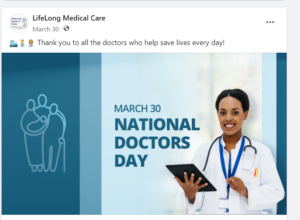
At Lifelong, 58% of the employees are people of color.
It was a light bulb moment for the clinician. Santiago approached her supervisors and RBN team members about finding more culturally relevant and appropriate ways to communicate with patients. She appreciates the value of a Spanish-speaking clinician support group so much, she says, “because most of our training is in English yet most of the services I provide are in Spanish,” says Santiago. “So, thinking of culturally appropriate and responsive services has been a main focus of that group.”
Even among Latinos, she says, clinics need to consider the diversity there is within the community itself. Off the Spanish-speaking support group, she says: “As a clinician I feel more seen, I feel more heard, I feel more empowered to continue the work.”
Healing patients and providers
For more than 45 years, LifeLong Medical Care has provided health, dental, and social services to underserved people. It provides urgent care, heart healthy and HIV-focused programs, substance use disorder clinics, and senior independence services. It serves residents in many East Bay cities, including Berkeley, Oakland, Richmond, Pinole, San Pablo, and Rodeo. Founded in 1976 to serve the unmet health needs of a growing senior population in Berkeley, today LifeLong is a federally qualified community health center that offers services to more than 61,000 individuals of all ages.
In addition, LifeLong has a strong commitment to eliminating health disparities and finding creative solutions to community health challenges. Take housing, which LifeLong recognizes as a core health issue. Together with community partners, it has developed a robust permanent supportive housing program that incorporates health and social services for adults experiencing homelessness. It has 15 supportive housing facilities in Berkeley, Oakland, and El Cerrito.
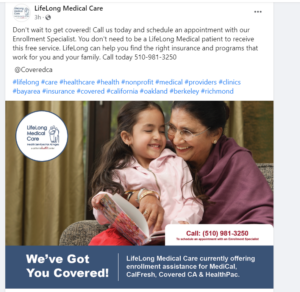
Lifelong welcomes all patients who need care
LifeLong is equally innovative in creating internal systems to support its trauma-informed care (TIC). To ease the time crunch in training, the organization has engaged a training coordinator to implement TIC training and a checklist tool for all new hires. “In February we had our very first TIC training for new recruits—it was a big push to get it off the ground,” Edmunds says. The three-hour in-person training is an adaptation of what’s known as TRIS, an acronym which stands for trauma and resilience informed systems. Besides giving new recruits a common language for trauma-informed care, she says, “it sends a message from the start: this is a priority of this organization.”
As with other clinics doing this kind of work, unexpected challenges or hurdles are common. LifeLong, which has school-based clinics in Berkeley, Emeryville, and Oakland, recently needed to set up conversations there about trauma related to school shootings. The RBN team discovered that providers serving patients at school-based sites need protocols advising them on how to respond to school shooters, student suicides, and other trauma.
As for next steps, Omotoso says LifeLong continues the work, exploring how to sustain this cultural shift and find sustainable funding to support patient-family interventions. There are no quick fixes here. But the organization is on the right path to continue to make trauma-informed care a priority.
Lessons Learned
Put staff first. Health centers have learned that providing trauma-informed care and becoming a trauma-informed organization cannot only focus on care of patients; they also must create a supportive environment for staff. This includes space for reflection, team debriefs, and team leaders providing access to resources as needed.
Help BIPOC clinicians feel connected. LifeLong’s Spanish-speaking clinician support group and contract with an external BIPOC group facilitator for staff of color are examples of ways to help BIPOC team members feel heard, seen, and valued. Edmunds also notes that the health center is actively recruiting for a director of diversity, equity, inclusion, and belonging. She adds that there is no one right way to address this issue, but it’s crucial to staff morale and retention to make it a top priority.
Dedicate time to trauma-informed care. Factor the work into clinicians’ schedules and set clear goals. It’s not an add-on: Incorporating trauma-informed care into program work helps team members work smarter. LifeLong is continuing to grow its work in this area: The health center’s ongoing ACEs screening pilot is built on the foundation of CCI’s resilience initiative, explains Omotoso. Before the pilot started, he says, LifeLong held formal trainings on staff wellness, trauma-informed care, and vicarious trauma. It also set up a working group of primary care providers and medical assistants to design (and revise) screening and referral workflows.
Reach out to the community. LifeLong has also formed partnerships with other local healthcare stakeholders, including La Clinica, First 5 Alameda County, and 211 Contra Costa, to connect patients’ with positive ACEs screening scores directly to community resources such as housing, food, and employment services.
Court buy-in from the top. It can be frustrating and counterproductive if management doesn’t endorse the value of the work, champion ambassadors, or make time for trauma and resilience training and work. That’s particularly important in an organization made up of many different clinics with different leadership, cultures, and goals. Someone from the top saying this work matters system-wide goes a long way to creating buy-in at all levels, according to LifeLong’s RBN team members. Case in point: the team went straight to the top to advocate for trauma-informed care training for new hires, notes Edmunds. It sends the message: This work is important, aligns with our mission and values, and we need to figure out how to do it.
Plan for sustainability and expansion. It’s not enough to want to screen all patients for ACEs or roll out trauma-informed care programs to all clinics. It takes active steps, forethought, buy-in, and engagement of stakeholders to make such wish list items a reality, says Edmunds, who recommends factoring that in from the start.
LifeLong Medical Care is part of the Resilient Beginnings Network, a learning program that promotes trauma- and resilience-informed care so that 100,000 young children and their caregivers in the San Francisco Bay Area have the support they need to be well and thrive. The Resilient Beginnings Network is powered by the Center for Care Innovations, an Oakland-based nonprofit that fosters health equity and innovation in the health care safety net, and by Genentech Corporate Giving.
LifeLong was earlier part of RBC, which included seven safety net organizations in the San Francisco Bay Area, including three other teams now in RBN: Marin Community Clinics, Petaluma Health Center, and San Mateo Health Center. (The lessons learned from that earlier program are covered in this Center for Community Health and Evaluation report.)
Find this useful or interesting? We’re constantly sharing stuff like this. Sign up to receive our newsletter to stay in the loop.

